TRIZCON2000: The Second Annual AI TRIZ Conference, Sheraton Tara, Nashua, NH, USA, Apr. 30 - May 2, 2000, pp. 21-35
Preface
for posting here in English (Toru Nakagawa, May 8, 2000)
This paper was presented last week at the TRIZCON2000 held near Boston by the Altshuller Institute of TRIZ Studies. The presentation was well accepted to the audience, even though the number of audiences was not large partly due to the parallel sessions. The author, and the Editor of this site, is very glad to be able to post the paper here again for wider circulation. The Altshuller Institute is generous in not claiming exclusive copyrights on the conference papers but in encouraging wider publication/circulation under authors' disposal. We are grateful to:
Altshuller Institute for TRIZ Studies http://www.aitriz.org/
This paper briefly reviews the history and activities of introducing TRIZ in Japan, and addresses that the difficulties for TRIZ to penetrate in industries are mostly in the difficulty for people to master the TRIZ way of thinking in problem solving. Necessity of simplifying TRIZ in problem solving procedure is addressed especially for beginners, and the USIT method (Unified Structured Inventive Thinking) developed at Ford Motor Company is recommended for such a purpose. For introducing TRIZ in Japanese industries, where TRIZ is still in its Infancy Stage of penetration, the "Slow-but-Steady" Strategy is recommended.
The present author expects that the "Slow-but-Steady" Strategy should be applicable in many countries/industries in the world. We should be happy to receive readers' comments/discussions from various countries/industries on how to introduce TRIZ.
A personal report of TRIZCON2000 by Toru Nakagawa is also posted today in Japanese. But we do not have a plan of translating it into English. (Translating the present paper into Japanese is not planned either for a time being.)
[Japanese
translation version is now posted. (Nakagawa, Feb. 28,
2001) ]
| Top | 2. History | 3. Classical TRIZ | 5. Problem Solving with USIT | 6. USIT Training | 7. Slow-but-Steady Strategy of Introducing TRIZ | References |
Abstract:
History and current activities of introducing TRIZ in Japan are summarized.
TRIZ has been introduced into Japan for these three years and gradually
getting popularity among pioneering engineers in industries. But
Japanese TRIZ learners/practitioners still have much difficulty in mastering
the way of thinking and in applying TRIZ to their actual problems.
For overcoming this difficulty, several textbooks have been published in
Japanese and a public WWW site "TRIZ Home Page in Japan" is serving.
Needs of easier process for creative problem solving has been recognized,
and USIT (Unified Structured Inventive Thinking) developed at Ford has
been introduced as a simplified TRIZ methodology. Case studies and
training practices of USIT are presented. The "Slow-but-Steady" strategy
of introducing TRIZ into Japanese industries is recommended.
1. Introduction
Since the recent introduction of TRIZ in Japan in 1996 - 1997, a handful of textbooks are already published in Japanese, TRIZ software tools of full Japanese version have been sold, and many introductory training seminars on TRIZ software tools have been given. Engineers and industries have gradually recognized TRIZ and started their trials of introducing it as a new methodology for innovative R&D.
But learners and practitioners in Japanese industries still feel much difficulty in applying TRIZ to their actual problems. Understanding of its methodology, i.e. the way of thinking, is more important and more difficult than learning usage of its software tools.
Under the current situation that real case studies in contemporary technologies have rarely been published because of companies' secrecy policies, beginners of TRIZ do not have enough chances of learning how to apply TRIZ. Thus even pioneering practitioners of TRIZ in industries do not have successful experiences of applying TRIZ yet in Japan.
For improving this situation, the "TRIZ Home Page in Japan" [1] has been established and operated by the present author as an open forum for information exchange on TRIZ on a non-profit basis. This WWW site has the unique position of being voluntarily operated in academia independently of any commercial company and is serving mainly for industries .
The present author understands that TRIZ has three main aspects: (a) methodology as a new viewpoint of technology, (b) methodology as a thinking way for problem solving, and (c) knowledge base as a collection of examples implementing the methodology (a) (See Table 1).
For introducing TRIZ in engineering and in industries, these three aspects
should be important as well. TRIZ software tools naturally put stress
on the knowledge base. Textbooks are useful for learning the methodology
(a), and further publication is desirable. Methods and materials
for learning the methodology (b) are the main issue of contemporary promotion
of TRIZ in Japan.
| Table 1. Three aspects of TRIZ and recommended materials | ||||||||||||
|
||||||||||||
Genrich Altshuller developed a large number of methods as thinking ways for problem solving and composed them into various versions of ARIZ [2]. Unfortunately, however, ARIZ is complex too much to master without intensive and long-term training under the TRIZ Founder or other TRIZ experts. This difficulty is the main bottleneck for the penetration of TRIZ, especially in Japan where personal training by TRIZ experts has been rare mostly because of the language barriers.
Easier and more practical methods are needed for realizing the Methodology (b) aspect of TRIZ. In this context, USIT (Unified Structured Inventive Thinking) [3], which was developed and successfully applied at Ford Motor Company by Ed Sickafus, was recognized as a suitable model. Thus, USIT has been introduced by the present author into Japanese TRIZ community. USIT training seminars have been carried out with success.
In the present paper, TRIZ history and activities in Japan are briefly introduced, and approaches to application of TRIZ in Japanese industries are presented and discussed.
2. History and Activities of TRIZ in Japan
As early as in 1972, TRIZ was first introduced into Japan. Altshuller's textbook of "Algorithms of Invention" (1969 edition) was published in Japanese translation [4] by engineering journalists. It was read by some people but did not make any substantial influence on them because there was no personal contact and no more information available for many years afterwards.
In April 1996, Nikkei Mechanical, a Japanese monthly journal, published Glenn Mazur's introductory paper [5] in Japanese translation with the catch copy of "Super-technique for invention". This article triggered the recent introduction of TRIZ into Japan. The journal, with Vice Editor Tsukasa Shinohara, published another article of case studies in March 1997; and later in every issue it has published series of lectures on TRIZ by Victor Fey and Eugene Rivin and then by Bolis Zlotin and Alla Zusman. Nikkei BP published three TRIZ textbooks in Japanese translation [6-8].
Another group led by Professor Yotaro Hatamura, the University of Tokyo, who have been working on creative design principles in mechanical engineering, recognized TRIZ since several years. Hiroshi Igata, an engineer in Toyota Motor Company and a former student of Hatamura, used Invention Machine's test versions of Invention Lab around 1995 during his stay at MIT, and opened a personal WWW site for introducing TRIZ. Hatamura's group published a textbook "Introduction to TRIZ" [9] in November 1997. It consists of two parts: one is the Japanese translation of Fey and Rivin's latest textbook [10], while the other is their own introduction to TRIZ including critical discussions on [10]. Hatamura's group recently published another textbook [11] to introduce TRIZ and their own Creative Design Principles in a more unified way.
In July 1997, Mitsubishi Research Institute [12], one of major think tanks in Japan, launched the promotion of TRIZ as the general agency of Invention Machine Corporation in Japan. MRI promoted the sales of the software tool TechOptimizer by giving demonstrations and introductory seminars to industries. It organized its industrial users into a consortium and working groups. With the backup of the MRI's consortium, IMC produced in January 1999 the full Japanese version of its TechOptimizer 3.0. MRI has been the most active TRIZ center in Japan having more-than-hundred user companies.
Sanno University [13], unique in its business-oriented education and consultation activities, started its TRIZ promotion in April 1998 as the general agency of Ideation International Inc. in Japan. Sanno's TRIZ specialists have been giving open/in-company seminars on TRIZ and consultations in industries. They also have the intention of applying TRIZ to management problems besides technological ones.
In this manner several tens of big manufacturing companies in Japan got their first knowledge on TRIZ around 1997 and 1998. Typically in such companies, one or a few pioneering engineers started learning TRIZ, tried to organize TRIZ seminars by outside promoters and to install TRIZ software tools. In such industries the catch copy of "Super-technique for invention" initially attracted much attention but at the same time had to face with widely-spread skepticism. Oldness of examples in TRIZ textbooks [6, 7, 9] and TRIZ software tools available at that time enhanced the skepticism and disappointment in the early stage of TRIZ promotion in Japan.
Further difficulty for such industry pioneers was to learn how to think in the TRIZ way and how to solve their real problems. Training seminars were not given enough even for such pioneers, partly due to cutting down of education costs under Japanese economical depression. Expensive software tools were bought, but often were not used actively. The predominant TRIZ software tools contained extensive knowledge bases and friendly user interfaces, but only very weak guiding processes. Users did not know effective ways of problem solving with the software tools.
Information available on Internet has made an increasingly important role for these years. It is especially true for a new and emerging area like TRIZ because of its quick publication and easy accessibility. The "TRIZ Journal" [14] has been known among Japanese TRIZ pioneering learners as a reliable source of information in English.
In November 1998, a WWW site named the "TRIZ Home Page in Japan" [1] started. Though it is edited and operated on a voluntary basis by the present author, it intends to be an open public forum for information exchange on TRIZ on a non-profit basis. It has posted many articles written mostly by the present author and introduced a number of excellent papers in Japanese translation, and is now regarded as the hub site on TRIZ in Japan. This site has English pages in parallel to Japanese pages and serves as an open window from/into Japan on a global basis.
Two international conferences on TRIZ were held in USA in November 1998 and in March 1999. They helped Japanese TRIZ learners understand the overall activities on TRIZ in USA and western countries. Activities in Russia and Belarus was also reported by the present author [15] on the WWW site as a result of his personal trip there.
Through these events the present author found the USIT method [3, 16, 17] developed at Ford should be most appropriate for introducing as an easy-to-apply problem solving process with the essence of TRIZ. Learning at the first out-of-Ford USIT Training Seminar conducted by Ed Sickafus, the present author posted introductory articles [18] and case study reports [19, 20] on his WWW site. He has given three-day USIT Training Seminars in Japan three times so far [21]. Thus this method has become known among TRIZ community in Japan.
Activities inside Japanese companies are not made open. Many big companies have already overcome the initial skeptical period and gradually brought up some pioneering TRIZ practitioners among their employees. Such companies belong to industries of machines, automobiles, electric appliances, high-tech information technologies, chemicals, and many others. Most of the practitioners, however, are not well authorized yet for promoting TRIZ in their company and still feel much difficulty in applying TRIZ to real problems.
Outside big companies, there are also many people who are studying TRIZ individually by textbooks and trying to apply it to their problems. These people form the bases of future penetration of TRIZ in Japan, just as seen in the history of quality control movements.
No significant products/processes have been reported as successful results of TRIZ application by Japanese companies so far. Real case studies with TRIZ are much desired in Japan for people to understand how to apply TRIZ.
In short, Japan is now in its infancy stage of introducing TRIZ. Thus the present author is recommending to Japanese industries for a "slow-but-steady strategy " of introducing TRIZ [22, 23]. In-company TRIZ pioneers have to find their own suitable ways to apply TRIZ to their real problems. But in a few more years from now, Japan would reach the emerging/growing stage of TRIZ.
3. Classical TRIZ As Is Understood
TRIZ has been established and developed by Genrich Altshuller and his students/associates for over fifty years, to form a system of wide and deep knowledge. The following is a rough sketch of the so-called Classical TRIZ, i.e. TRIZ developed before 1985, as understood by the present author [22, 23].
3.1 Methodology (a): New Viewpoint of Technology
The most important contribution of TRIZ is its establishment of a new
viewpoint of technology and science characterized by its bottom-up technology-based
approach. Its features may be listed as follows:
(1) Concrete knowledge and abstract concepts together, making bridges between specialists' practices and scientists/engineers' academic work;(2) Insights into the history of technologies, revealing trends in the technology evolution;
(3) Searching from the targets for the means, forming an inverse database of science and technology by using hierarchical classification of the target functions and a collection of scientific/technological knowledge;
(4) Patterns of inventive thoughts in the form of the "40 Principles of Invention"
(5) Formulation of problems into the "Contradiction Matrix" with the concepts of "Technical Contradictions" and the 39 parameters, and giving hints to solution in the form of frequently-used Principles of Invention;
(6) Formulation of problems with the concept of "Physical Contradictions" and giving "Separation Principles" for the hints to solutions;
(7) Formulation of problems with the "Substance-Field Analysis" and giving "76 Standards of Solution" for the hints.
3.2 Methodology (b): Thinking Way
for Problem Solving
(8) Using abstract model of problem & solution, i.e. first finding an abstract model for user's actual problem and then trying to realize the model solution into actual solution;(9) Imaging the goal first, especially using the concept of "Ideal Final Result", and coming back to the solution means so as to eliminate trial-and-error searching;
(10) Clarifying contradictions in the problem and trying to find a break-through solution without compromise;
And many more methods, such as Smart Little People Method, System
Operator (or Multi-Screen Method), STC Operator (Size-Time-Cost Operator),
etc. All these methods are built into ARIZ [2]
having a lot of iteration cycles for solving difficult inventive problems.
3.3 Knowledge base
For all the systematic concepts and viewpoints listed in Section 3.1, collections of examples have been accumulated from the analyses of world-wide patents, scientific knowledge, and technologies. They have been implemented later in the databases of TRIZ software tools.
3.4 General Scheme
The general scheme established by TRIZ may be illustrated in Fig. 1
[22].
The upper part shows the world of information in science and technology,
while the bottom part the world of user's own problem. It is not
easy for users to utilize the science and technology for solving their
problems. Now that TRIZ has provided various information extracted
from science and technology, the users can find much easier ways to reach
from their problems to their solutions.
| . |
Fig. 1. Scheme of TRIZ methodology for problem solving |
This scheme in Fig. 1 was designed into the symbol mark of the "TRIZ
Home Page in Japan" [1] as shown in Fig. 2.
 |
|
| . |
Fig. 2. Symbol mark of the TRIZ Home Page in Japan ((C) 1998) |
4. Towards Modernized TRIZ
Since around 1985, i.e. the era of Perestroika in ex-USSR, many groups of TRIZ experts started their own approaches to modernize TRIZ. The transfer of TRIZ from the former socialist society in USSR to the present business-competition society in the West urged the modernization of TRIZ. TRIZ is now facing the problem how to penetrate into companies, i.e. into the mass of industrial engineers.
Three approaches which are influential on Japanese TRIZ community are briefly mentioned here:
4.1 Approach by Ideation International[24]
Alla Zusman mentioned in [25] that the most important issue for the modernization of TRIZ is to show an easy process of utilizing Altshuller's various methods.
Their solution is a new network-type diagram which represents the causal relationships in the problem with distinction between useful and harmful effects. With the input of such a diagram, the III's software tool outputs a check list of possible view points of the problem. Then the users are advised to consider all view points in turn by applying some suitable methods selected among the original TRIZ algorithms. Diagrams of causal network allow to be used for technical and non-technical problems as well, thus expanding the application area of TRIZ.
4.2 Approach by Invention Machine[26]
IMC has developed user-friendly software tools of TRIZ knowledge bases running on personal computers. Especially, the Effects database has been continuously expanded and are useful for users to learn relevant physical/chemical principles and technical means.
Valerie Tsourikov of IMC is making much efforts to make the tool TechOptimizer intelligent. The tool can automatically search and propose sequentially-linked techniques having the given key technique at the final node of the sequence. This serves engineers to devise new techniques exactly in one of their typical ways of design thinking. He says that IMC has developed a conceptual dictionary and a conceptual network representation technique as the basis for their artificial intelligence.
IMC's software tools are already developed at the level of practical effectiveness in industrial applications and are penetrating widely into businesses in Japan as well as in USA and others.
4.3 Approach of USIT at Ford Motor Co.
At Ford Motor Company, a different approach to TRIZ has been developed and practiced by Ed Sickafus [16, 17]. The approach, USIT [3], is a much simplified version of TRIZ for creative problem solving.
In 1980s Genedy Filkovsky realized in Israel the necessity of simplifying TRIZ for easier training/practice. He reduced Altshuller's 40 Principles of Invention into only four solution techniques and formed the SIT (Systematic Inventive Thinking) method. SIT was recently published by Roni Horowitz et al. [27] with the emphasis of solutions in the "closed-world" and with "qualitative change" as the "sufficient conditions of invention".
Sickafus [17] adopted SIT (after a close comparison with TRIZ itself) and started a training program of USIT in 1995. He made his USIT as an easy-to-practice procedure for creative concept generation at the most upstream of product/process development. USIT does not concern engineering details, so does not use technical databases and software tools. The main target of USIT is for industrial engineers to generate multiple concepts as rapidly, freely, and creatively as possible. Thus Sickafus reduced the emphasis on seeking for invention in TRIZ, for the sake of wider practical application.
Activities of USIT application at Ford [16] were reported in conferences. They seem to be the most successful case published so far, and form an excellent model of introducing TRIZ into industries.
4.4 Issues of Modernizing TRIZ
A recent overview by James Kowalick [28]
is helpful to understand the needs and approaches for modernization of
TRIZ. He discusses two aspects of TRIZ; one as a problem-solving
methodology and the other as a creativity-increasing methodology.
Let us focus on the first aspect in the present paper. Table 2 summarizes
Kowalick's views of (A) limitations and problems in traditional TRIZ, and
(B) future directions.
| Table 2. Problems in traditional TRIZ and Future Directions | |||||||||||||||||||||
|
|||||||||||||||||||||
The current approaches by the present author are summarized in the right column in Table 1. They are close to Kowalick's future directions, as shown in Table 2 Column (C), and are presented some more in the following sections.
5 Problem Solving with USIT
For presenting the present author's approaches, the problem solving process with USIT need to be illustrated with some example. That is because no handy papers have been published so far by Sickafus concerning the USIT process itself, even though an intensive textbook [3] was published already. Articles posted by the present author in his WWW site may be handy reference to USIT processes [18] and case studies [19, 20] (See also [29]).
5.1 Flowchart of the USIT process
USIT has a clearly-defined scheme of process as illustrated by the flowchart
shown in Fig. 3. (This flowchart was drawn by the present author
after slightly modifying Sickafus' chart.) It has three stages: problem
definition stage, problem analysis stage, and solution generation stage.
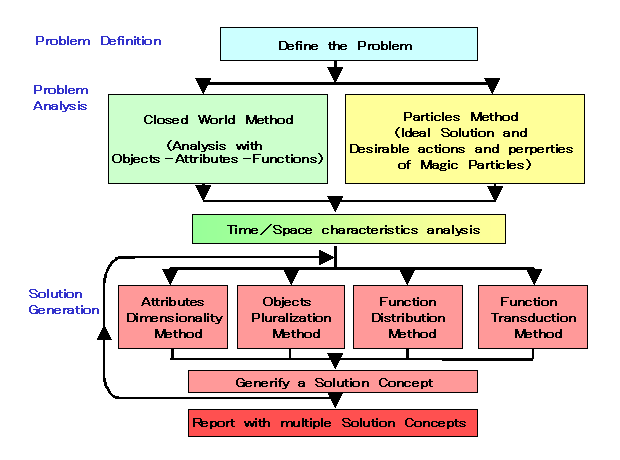 |
|
| . |
Fig. 3. Flowchart of the USIT process |
5.2 Problem Definition Stage
Figure 4 demonstrates an example of output of the problem definition
stage for a practical case [20] carried out
by the present author during Sickafus' USIT Training Seminar in March 1999.
This stage requests the analyzer to write down the problem statement (in
one or two lines), sketch of the problem situation, root cause (one or
a few plausible causes), and a list of objects in the problem system.
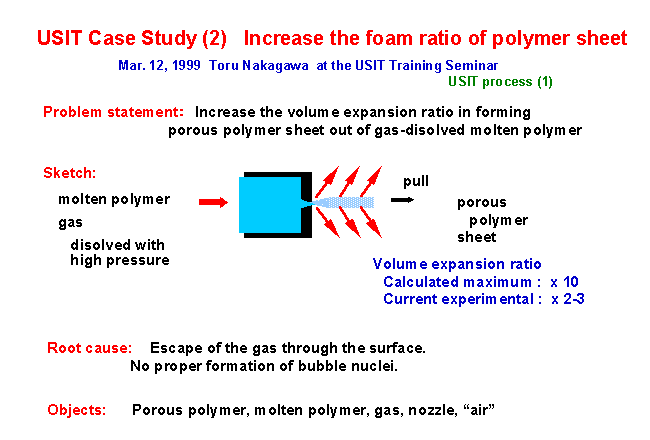 |
|
| . |
Fig. 4. Output of USIT problem definition |
This task seems very simple at first sight. But such a brief problem statement and root cause statement request the analyzer to clearly define the problem and to sharply focus the problem solving efforts. Trainees at USIT Seminars very often say that they have realized at the end this problem definition stage most crucial for fruitful problem solving.
5.3 Problem Analysis Stage
There are three analysis methods as shown in Fig. 3. Either or both of (a) Closed-World method and (b) Particles method should be applied, and then (c) Space/Time Characteristics Analysis method follows.
5.3.1 Closed-World method
This method starts with the analysis of the present system in the problem. It seems to retain the ideas of Israeli SIT strongly, even though clearer definitions of the concepts of Objects, Attributes, and Functions were introduced.
First the Closed-World Diagram is constructed to represent the functional relationships among objects from the viewpoint of original designer's intention. Objects are arranged vertically with the most important object at the top and others follow in the favorable functional relation toward the upper one. Sickafus has set a rather strict guideline for drawing this diagram. (One weak point: this diagram lacks the presentation of the harmful or ill functions.)
Then the Qualitative Change Graphs are drawn. Actually, there are two fixed graphs, showing increasing and decreasing relationships. The task for the analyzer is to select a suitable effect or function as the ordinates and then to list up relevant attributes as the abscissas. While performing this task the analyzer recognizes a large number of attributes of the system's objects and their relationship to the intended function or to the ill effect of the problem.
In Israeli SIT [27], the analyzer is advised to think of inventive solutions with restriction that different types of object should not be introduced in the Closed World and that the solution should cause some Qualitative Change in relationship (i.e. increasing relationship turns into decreasing/non-increasing, and vice visa) with some attribute.
In USIT these two requirements in SIT are not stressed so much for the purpose of generating multiple creative/practical solutions. CW Diagram and QC Graphs may be regarded as means to clarify the functional relationships and qualitative dependence on various attributes. For a case study using the Closed World Analysis, see [19].
5.3.2 Particles Method
Particles Method is an adoption of Altshuller's Smart Little People Method. It requests the analyzers to imagine an ideal result first instead of trying to analyze the present system. Figures 5 and 6 illustrate the outputs of this method for the problem in Fig. 4.
First the problem state is sketched as shown at the top-left in Fig.
5; a close-up view at the nozzle is drawn to clarify the mechanism/problem
of foam formation.
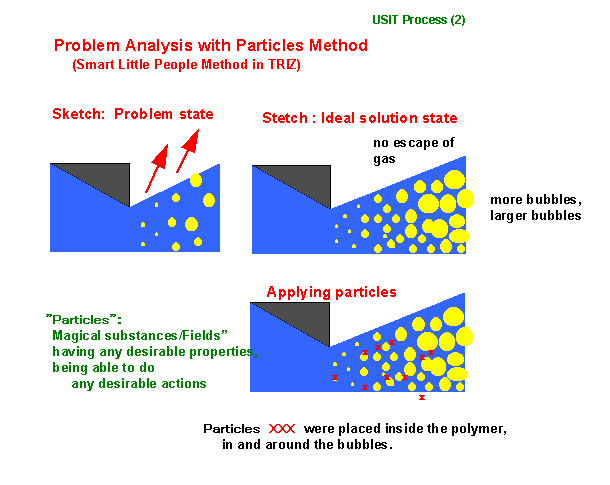 |
|
| . |
Fig. 5. Example of sketches in the Particles Method in USIT |
Then the ideal solution state is imagined and drawn at the top-right in Fig. 5. Just the ideal result should be drawn without thinking/drawing any possible means to achieve it. Next, at the positions where differences occur in the two sketches, the x marks are drawn, and they are called "Particles". Particles are regarded as magical substances/Fields having any desirable properties and being able to do any desirable actions. The x marks for "Particles" are found more useful for abstract thinking than human figure marks for "Smart Little People".
In the next step, the analyzer is urged to think what kind of actions
should be asked for the Particles to perform. Such desired actions
are broken down into a hierarchical diagram as shown in Fig. 6 with clarifying
the AND/OR conditions between the lower nodes. Then for each desirable
action, possible desirable properties of the Particles should be listed
up as freely as possible.
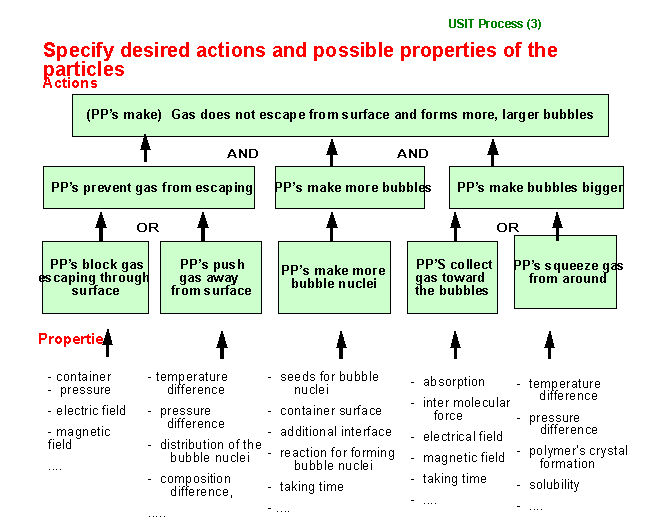 |
|
| . |
Fig. 6. Example of desired actions and properties in the Particles Method in USIT |
It is advised to use plain everyday words instead of technical terms for the actions, so as to be free from constraint of conventional technical thinking. While constructing the Particles' action/property diagram, the analyzer often think of various elements of ideas. Such ideas should be memorized.
5.3.3 Space/Time Characteristics Analysis
Next, the characteristics of either the problem state or the ideal state
should be analyzed with respect to the space and to the time. Either
the problem's harmful effect or the system's functional performance should
be taken as the ordinates of the graphs. Then choosing some proper
coordinates of space and time as abscissa, the characteristics of the system
are to be drawn schematically. Figure 7 illustrates such graphs drawn
for the present model case.
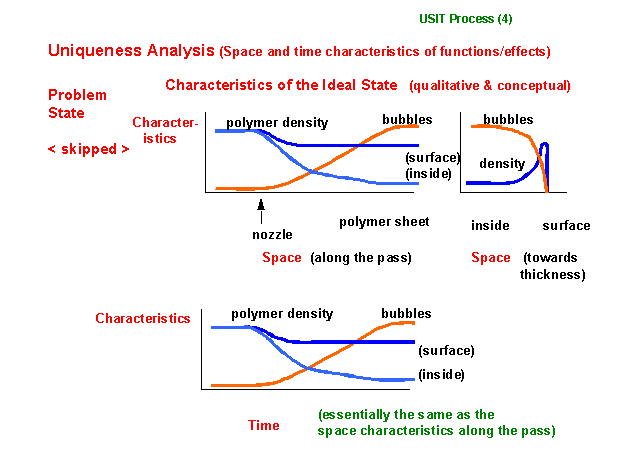 |
|
| . |
Fig. 7. An Output of the Space/Time Characteristics Analysis in USIT |
5.4 Solution Generation Stage
USIT has four techniques for solution generation and uses them repeatedly together with the generalization process as shown in the flowchart in Fig. 3.
5.4.1 Four Solution Generation Techniques
The four techniques correspond to the operations on the objects, attributes,
and functions in the system in the following way:
(a) Attributes Dimensionality Method: Operations on attributes; activating/deactivating attributes, changing time dependence of attributes, qualitative change of attribute characteristics, etc.(b) Object Pluralization Method: Multiplying and dividing each object, from zero (i.e. trimming) to infinity.
(c) Function Distribution Method: Distribute the functions, to different objects, with replacing/unifying functions, etc.
(d) Function Linkage Method: Link functions sequentially to devise new/enhanced effects.
5.4.2 Generalization of solutions
In USIT it is advised to generalize each solution by using more generic
terms, so as to enhance associative thinking from wider viewpoints.
By using the generalization, solution ideas are enhanced in the scheme
shown in Fig. 8. This scheme is simple but powerful for expanding
new ideas and for viewing the search space systematically. (This
scheme is called with different names, such as road map
[30], mind mapping [28], etc.)
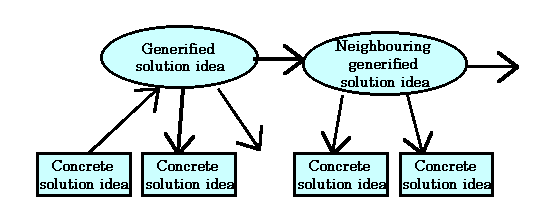 |
|
| . |
Fig. 8. Generification scheme in USIT |
5.4.3 Practices of Solution Generation
The four solution generation techniques may be used in any order and are recommended to be applied to all the objects, attributes, and functions in the system in turn. In the cases where the Closed-World Method was used for the analysis stage, these four techniques are relatively easier to be applied one by one to the system elements. On the other hand, in the cases where the Particles Method was used for the analysis, solution ideas often come much more smoothly and abundantly without applying the four techniques in such a conscious/analytical manner.
Figure 9 illustrates the solution concepts obtained for the model problem
[20].
This results were obtained at Sickafus' USIT Training Seminar essentially
in one day. These solution concepts were written down smoothly on
the basis of the analyses shown in Figs. 6-8.
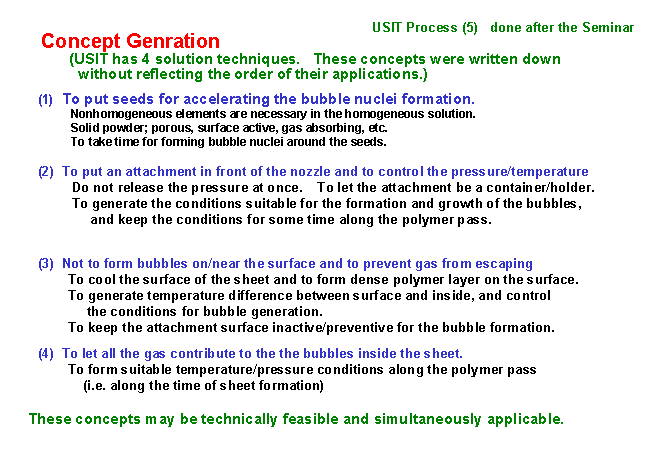 |
|
| . |
Fig. 9. Example of multiple solutions output by USIT |
6. Practices of Training USIT in Japan
After attending at USIT Training Seminar [18] conducted by Ed Sickafus, the present author has tried to introduce USIT into Japan by conducting similar training seminars. He has experiences of giving three-day USIT Training seminars; twice in two different companies and once at MRI to engineers coming from various companies. The last one is reported here as a model case [21].
6.1 Organization and the Secrecy Agreement
Last December at the Creative Methodology WG Meeting organized by MRI, a three-hour lecture on USIT was given to about 45 TRIZ pioneers coming from various industries in Japan. Then a USIT Training Seminar was held by MRI in January for three days, where the present author served as the instructor. Twelve engineers from 10 different companies took part in it; 8 participants are TRIZ pioneers in their companies, and 4 others are relatively new learners of TRIZ.
The objective of the Seminar was to master USIT through group practices of applying it to real problems. This type of training was supposed to be much more effective [28] than the ones with lectures and textbook practices only. Bringing real problems into a seminar should certainly contribute to better motives for the participants, but is often suppressed by their companies in order to protect their secrecy and intellectual properties. This problem had to be overcome beforehand.
In this relation, a contradiction which hinders the penetration of TRIZ had long been recognized : "For beginners to learn TRIZ, good examples of successful cases are helpful. But the better the application results are, the less chances to be published because of companies' secrecy policies. Thus the beginners do not have chances to study good cases, and remain as beginners." This "TRIZ Case-Study Contradiction" became clear in USA, Europe, Japan, etc. A solution in USA to bypass this contradiction is the personal training by many TRIZ experts, Russians and then Americans. Japan has to find another solution for overcoming it.
Our solution, for bringing in real problems in the seminar and for overcoming the TRIZ Case-Study Contradiction at the same time, was the Secrecy Agreement announced beforehand and signed by all the parties involved in the USIT Training Seminar. Its outline [21] is:
Every participant of the seminar should bring in his/her real but non-confidential problems into the seminar. Among such brought-in problems, a few should be chosen by the seminar members to practice at the seminar. All the output of the seminar on a problem are allowed for the proposing person and his/her company to utilize exclusively for six months after the seminar, e.g. to file patents. If any contribution by other members is essential, such members should be named among the inventors but should transfer all commercial rights to the proposing person and the employer without claiming any reward. Any participant (including the instructor) other than the proposing person should not disclose or report even inside his/her company on any technical issue of the problems for six months. After six months of the seminar, every participant and the instructor may report/publish the technical contents of the seminar and may utilize the outputs of the seminar for his/her own purpose.
With this agreement, four real brought-in problems were chosen to solve at the seminar and all the participants could discuss on the problems actively and cooperatively.
6.2 USIT Training Program
The three-day training program [21] is
outlined in Fig. 10. After introductory lectures on TRIZ and USIT,
group practices for solving four real problems in parallel were carried
out according to the USIT procedure.
| . |
Fig. 10 Program of USIT Training Seminar |
Every session of group practice is composed of
- a short lecture on the step,This was adopted from Sickafus' seminar, and is effective to make the participants highly motivated. Every participant solves one problem in a three-member group, and also joins the presentations and discussions of other three problems.
- parallel practices in groups on the assigned real problem, and
- sequential presentations by the groups to all the members, with instructions and discussions.
Each problem was analyzed with the Closed World Method and then with the Particles Method. For the solution generation stage, participants are advised to proceed as:
- first, to generate solutions using the results of Particles Method and Space/Time Characteristics Analysis rather freely,
- then, to think more using the four techniques on the results of CW Method,
- at the second session, to systematize and examine the solutions with the generalization method,
- finally, to select several most promising solutions and to enhance and strengthen them.
The participants have solved the four brought-in problems with multiple
solutions successfully and found the USIT process easy and effective.
In coming August, these case studies will be reported publicly including
its technical issues.
6.3 USIT As Evaluated in Japan
USIT has been evaluated highly in Japan by the audiences and participants
of the seminars:
(1) USIT is much easier to learn than TRIZ.
=> One or two USIT experts should be brought up in each company, and they should train many engineers in in-company training programs to understand USIT.(2) USIT fits well for group work.
=> The USIT experts should make temporary joint teams with engineers for solving problems brought in by engineering departments, just like the model at Ford [6].(3) USIT is applicable to real problems.
=> Application should be tried to real industrial problems at their concept-generation stage.(4) Engineering details should be considered after USIT.
=> (Though the USIT group at Ford is not involved explicitly,) the processes for after-USIT stages need to be considered, especially in relation to TRIZ software and other designing/quality methodologies.
7. "Slow-but-Steady" Strategy
For introducing TRIZ into Japanese industries, the present author is
advising to take the "Slow-but-Steady" Strategy, in contrast to more hurrying
and forcing strategies, as compared in Table 3.
| Table. 3 Comparison of Two Strategies for Introducing TRIZ | ||||
|
Practical process in a company may be illustrated in Table 4.
It is essential NOT to enforce any individual or organization to use TRIZ
in any specific way.
| Table. 4. Practices of the Slow-but-Steady Strategy for Introducing TRIZ in industries | |||||||||
|
It should be noticed that the strategy recommended here is in contrast to those currently typical to the Total Quality Control and related movements. Main reasoning for the present author's strategy is:
- TRIZ is not understood well yet in Japan in its infancy stage of penetration.
- TRIZ is a methodology in technology in its essence. Quality control movements have been based on methodologies in data analysis and in organization theory, and not in technology itself.
- Grass-root penetration has been the unique TRIZ way established by Altshuller.
- Thinking with TRIZ should not be enforced on people, to make them creative in thinking.
- Hurrying and forcing strategy would cause indigestion and harmful effects in a long run.
The TRIZ methodology is so deep and wide that it should better be
introduced to the field of technologies and industries with the slow-but-steady
way for taking time to understand its real essence in its infancy stage
of penetration in Japan.
Acknowledgement: The present author is grateful to Dr. Ed Sickafus of Ford Motor Co. for his kind instruction and continuing encouragement for introducing USIT into Japan.
References
[1] "TRIZ Home Page in Japan", WWW site
edited by Toru Nakagawa. URL: http://www.osaka-gu.ac.jp/php/nakagawa/TRIZ/eTRIZ/
(in English), http://www.osaka-gu.ac.jp/php/nakagawa/TRIZ/ (in Japanese).
(Note: These are abbreviated here as "TRIZ HP Japan".)
[2] Genrich S. Altshuller: "The History
of ARIZ Development", Journal of TRIZ 3, No. 1, 1992; English translation
by Bolis Zlotin and Alla Zusman, Technical Papers, Ideation International,
URL: http://www.ideationtriz.com/.
[3]
"Unified Structured Inventive Thinking: How to Invent", Ed. N. Sickafus,
NTELLECK, Grosse Ile, MI, 1997, 488p.
[4] "Hatsumei Hassou Nyumon (Introduction
to Inventive Idea Generation)", K. Endo and T. Takada, Agune-sha, 1972
(J)
[5] Glenn
Mazur: "Super Technique for Invention: TRIZ", Nikkei Mechanical, No.
477, pp. 38-47; No. 478, pp. 47-54 (Apr. 1996). (J)
[6] "Principles and Concepts of TRIZ",
Super Invention Technique TRIZ Series, Vol. 1, translated by K. Endo
and T. Takada, Nikkei BP, Tokyo, Nov. 1997, 187p. (Japanese translation
of "Algorithms of Invention", Genrich Altshuller, 1969).
[7] "Application of TRIZ to Examples",
Super Invention Technique TRIZ Series, Vol. 2, translated by Mitsubishi
Research Institute, Nikkei BP, Tokyo, Oct. 1997, 177p. (Japanese translation
of "And Suddenly the Inventor Appeared", Genrich Altshuller, 1984, from
the English version translate by Lev Shulyak, 1997).
[8] "Illustrated 40 Inventive Principles",
Super Invention Technique TRIZ Series, Vol. 3, translated by Nikkei BP,
Nikkei BP, Jan. 1999, 159p. (Japanese translation of
"40 Principles: TRIZ Keys to Technical Innovation", Genrich Altshuller,
with new materials by Lev Shulyak, Tech. Innovation Center, 1997, with
further addition of technical examples taken from articles in Nikkei Mechanical).
[9] "Introduction of TRIZ", Yotaro Hatamura
et. al., "An Introduction to TRIZ", Nikkan Kogyo Shimbun, Tokyo,
Dec. 1997. (Japanese translation from and comments on "The Science of Innovation"
by V.R. Fey and E.I. Rivin).
[10] "The Science of Innovation", Victor
R. Fey and Eugene I. Rivin, TRIZ Group, Southfield, MI, USA, 1997, 82p.
[11] "Knowledge Management for Designing:
Creative Design Principle and TRIZ", Masayuki Nakao, Yotaro Hatamura, and
Kazutaka Hattori, Nikkan Kogyo Shimbun, Tokyo, Dec. 1999. (J)
[12] Mitsubishi
Research Institute, ITD/TRIZ Project. http://www.internetclub.ne.jp/IM/.
(J & E)
[13] Sanno University, TRIZ Project. http://www.hj.sanno.ac.jp/triz/.
[14] "TRIZ Journal", WWW site edited by
Ellen Domb and Michael Slocum. URL: http://www.triz-journal.com/
[15] Toru Nakagawa: "Report
of A Personal Trip to TRIZ Mother Countries (Russia & Belarus, Aug.
1999), TRIZ HP Japan, Sep. 1999. (J & E)
[16] Ed Sickafus: "Injecting
Creative Thinking into Product Flow", First TRIZ International Conference,
Nov. 1998, Industry Hills, California; TRIZ HP Japan, Jan. 1999 (J).
[17] Ed Sickafus: "A
Rationale for Adopting SIT into a Corporate Training Program", TRIZCON99:
First Symp. on TRIZ Methodology & Application, March 1999, Novi,
Michigan; TRIZ HP Japan, May, 1999 (J).
[18] Toru Nakagawa:
"USIT Training Seminar (Instructor: Ed Sickafus, Mar. 1999)", TRIZ
HP Japan, Mar. 1999. (J & E)
[19] Toru Nakagawa: "USIT
Case Study (1) Detection of Small Water Leakage from a Gate Valve",
TRIZ HP Japan, Jul. 1999. (J & E)
[20] Toru Nakagawa: "USIT
Case Study (2) Increase the Foam Ratio in Forming a Porous
Sheet from
Gas-Solved Molten Polymer", TRIZ HP Japan, Jul. 1999. (J & E)
[21] Toru Nakagawa:
"USIT Training Seminar in Japan: (2) 3-day Seminar with Multi-company Engineers",
TRIZ HP Japan, Feb. 2000. (J & E)
[22] Toru Nakagawa: "TRIZ:
Theory of Inventive Problem Solving -- Understanding and Introducing
It --", Bulletin of Cultural and Natural Sciences in Osaka Gakuin University,
No. 37, Sept. 1998, pp. 1-12. (J); TRIZ HP Japan, Feb. 1999 (J & E).
[23] Toru Nakagawa: "Let's
Learn 'TRIZ'! -- A Methodology for Creative Problem Solving". Plant
Engineers, Vol. 31 (Aug. 1999), pp. 30-39. (J); TRIZ HP Japan, Oct. 1999.
(J & E)
[24] Ideation International Inc., WWW
site: http://www.ideationtriz.com/.
[25] Alla Zusman, "Progress in TRIZ: Roots,
Structure and Theoretical Base", TRIZCON99: First Ann. Altshuller Inst.
Conf. on TRIZ, Novi, Michigan, Mar. 7-9, 1999.
[26] Invention Machine Corp., WWW site:
http://www.invention-machine.com/.
[27] Roni Horowitz and Oded Maimon: "Creative
Design Methodology and the SIT Method", 1997 ASME Design Engineering
Technical Conference, Sacramento, California, Sept. 14-17, 1997.
[28] James Kowalick: "Problem-Solving
Systems: What's Next after TRIZ? (With an Introduction to Psychological
Inertia and Other Barriers to Creativity)", 4th Ann. Intern'l. TPD
Symp. - TRIZ Conf., Industry Hills, California, Nov. 17-19, 1998, pp. 67-86;
TRIZ HP Japan, Jan. 1999 (J).
[29] Toru Nakagawa: "USIT:
Creative Problem Solving Procedure in Simplified TRIZ", Design Engineering
(JSDE), Vol. 35, in press, Mar./Apr. 2000 (J).
[30] Michael Lynch, Benjamin Saltsman,
and Colin Young: "Windshield/Backlight
Molding -- Squeak and "Buzz" Project -- TRIZ Case Study", American
Supplier Institute Total Product Development Symposium, Nov. 5, 1997,
at Dearborn, Michigan, USA; The TRIZ Journal, Dec. 1997; TRIZ HP Japan,
Sep. 1999 (J).
About the Author
Toru Nakagawa is currently Professor of Information Science at Osaka Gakuin University. Since he was first exposed to TRIZ in May 1997, he endeavored to introduce it into Fujitsu Labs for which he was working. After moving to the University in April 1998, he has been working for introducing TRIZ into Japanese industries and academia. In Nov. 1998 he founded the public WWW site "TRIZ Home Page in Japan" and serves as the Editor.
He graduated the University of Tokyo in chemistry in 1963, studied at
its doctoral course (receiving D. Sc. degree in 1969), became Assistant
in Department of Chemistry, the University of Tokyo in 1967; he did research
in physical chemistry, particularly experiments and analyses in the field
of high-resolution molecular spectroscopy. He joined Fujitsu Limited
in 1980 as a researcher in information science at IIAS-SIS and worked for
quality improvement of software development. Later he served as a
managing staff in IIAS-SIS and then in R&D Planning and Coordination
Office in Fujitsu Labs.
| Top | 2. History | 3. Classical TRIZ | 5. Problem Solving with USIT | 6. USIT Training | 7. Slow-but-Steady Strategy of Introducing TRIZ | References |
| Top of this page | Let's Learn TRIZ! | USIT: Creative Problem Solving Procedure with Simplified TRIZ | USIT Training Seminar in Japan (2) | Japanese page |
| Home Page | New Information | Introduction to TRIZ | TRIZ References | TRIZ Links |
| TRIZ News & Activities | TRIZ Software Tools | TRIZ Papers and Tech Reports | TRIZ Forum |
Last updated
on May 8, 2000. Access point: Editor: nakagawa@utc.osaka-gu.ac.jp